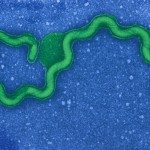Link to Pubmed [PMID] – 17993560
Appl. Environ. Microbiol. 2008 Jan;74(1):319-22
Our understanding of leptospiral pathogenesis, which remains poorly understood, depends on reliable genetic tools for functional analysis of genes in pathogenic strains. In this study, we report the first demonstration of conjugation between Escherichia coli and Leptospira spp. by using RP4 derivative conjugative plasmids. The DNA transfer described here was due to authentic conjugation, as shown by the requirement for cell-to-cell contact and the resistance of DNA transfers to the addition of DNase I. Transposition via conjugation of a plasmid delivering Himar1 yielded frequencies ranging from 1 x 10(-6) to 8.5 x 10(-8) transconjugants/recipient cell in the saprophyte L. biflexa and the pathogen L. interrogans, respectively. Analysis of mutants indicated that transposition occurs randomly, and at single sites in the genome of these strains, allowing the utilization of this system to generate libraries of transposon mutants.

